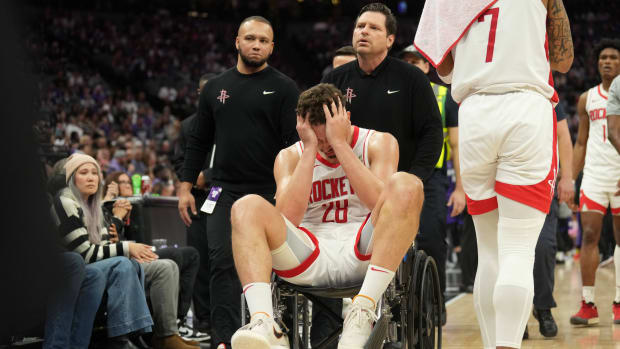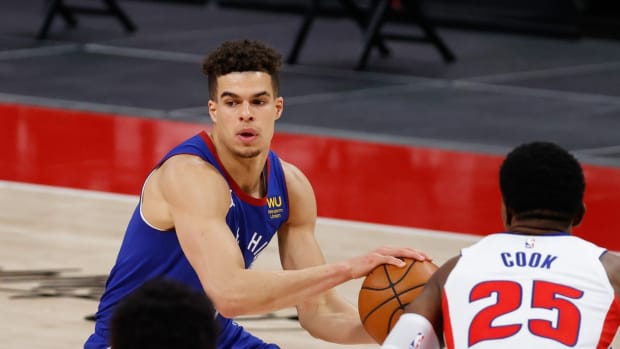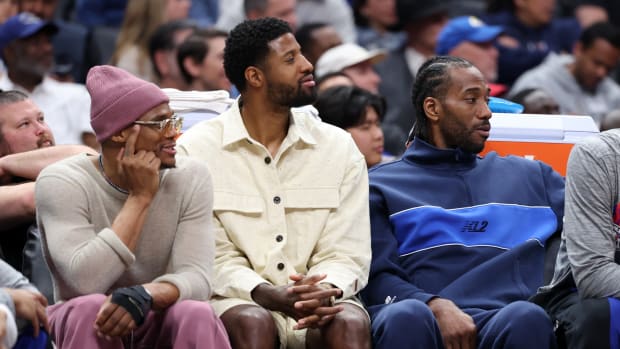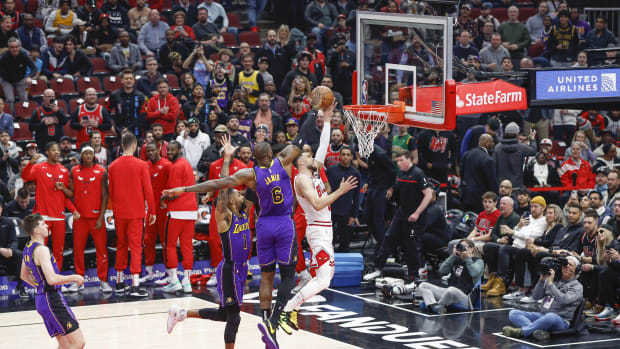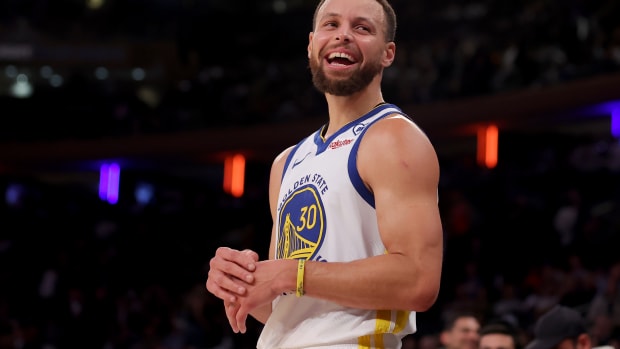How a Lakers Photographer Captured LeBron in the Perfect Moment
Throughout Andrew Bernstein’s nearly four decades taking photos for the NBA, the longtime Lakers photographer has captured no shortage of iconic basketball moments. Scroll through his website and you can see the framework of recent NBA history. There are photographs of Magic Johnson tangling up with Larry Bird, images of Johnson and Michael Jordan together and pictures of the young No. 8 Kobe Bryant flying above opposing players. He’s even captured Bryant dunking on LeBron James and documented Stephen Curry’s euphoria when celebrating an NBA championship.
But Bernstein, who is also the official team photographer for the Clippers, Kings and Sparks, says the photograph that he took on Thursday night of James soaring for a reverse windmill dunk against the Rockets has probably gotten the most play in the moment of any of his images.
Less than a day after capturing the all-time great photograph, the longest-tenured senior photographer with the NBA caught up with Sports Illustrated to discuss the process behind taking the picture, why it might have resonated with so many people and how photographing James is different than photographing Bryant.
The Q&A below has been edited for length and clarity:
Ben Pickman: Take me through the process of capturing LeBron’s windmill dunk with just over 8:30 to go in the third quarter?
Andrew Bernstein: I employ a system of multiple remote cameras that are set up on the opposite side of the court from where I sit. So essentially on Thursday night, I think we had five different remote cameras in different locations, all sort of aimed on the front of the basket area. And that is triggered by a remote-trigger button attached to the one camera I use to shoot downcourt. So I have to decide basically within a split-second whether I’m going to shoot with the camera that’s in my hand, the one that I’m looking through. If I think it’s a good “remote shot,” I will bang the remote button.
Our flash wizard system allows you to shoot multiple cameras that are synchronized together on one strobe burst. So you see in that photo two giant strobe bursts going off on either side of the scoreboard. I can only shoot one shot every four seconds with that system because I’m on strobes and the strobes take four seconds to recycle back up.
Honestly, it’s really a matter of a lot of elements coming together. Mostly the player has to be in the right place in the focus zone, because we have a very specific area in front of the basket where the focus zone is. I have to time it correctly obviously, and I’m sitting on the other side of the court. There’s an element of luck in there, but as the great Sports Illustrated photographer Walter Iooss, one of the godfathers of sports photography, said, “that luck benefits the most prepared.” It’s all about preparation. It’s a lot that came together to get that picture.
BP: When LeBron was streaking downcourt, what was going through your mind?
AB: I obviously saw the play develop and he had a breakaway pretty much three-quarters of the court. I saw him go up and instinctively knew when to push the remote button. When I saw him bring the ball down when he was in the air, in that millisecond, that’s when I banged the remote button. I honestly anticipated that I shot it a little late and that I probably had the ball like halfway up which, would not have been a good picture. The ball probably would have blocked his face.
BP: Did you know you captured this stellar photograph immediately after the play?
AB: I watched the replay on the screen—they showed it twice—and I can see in the replay when the strobes go off so I kinda have an idea if I was late. Very rarely are you early, but usually you’re late. It looked like I was probably pretty close to timing it right so I texted my assistant who is in the backroom receiving the images along with the editor back in New Jersey at NBA Photos and I said, “Hey, when that comes across, I’d love to see what the different angles look like.” Of all the five angles that was the one that got it the best. This particular angle we call the floor remote.
BP: Why do you think this photograph resonated with so many people?
AB: That’s a really good question because I did not expect that kind of reaction. It was a pretty amazing reaction. I think it was a combination of things. It’s a moment frozen in time. It’s LeBron. It’s LeBron in his 17th year. People not really seeing him dunk like that, like the young LeBron used to.
And, I think it’s just a cool picture. I think the symmetry of it. He’s really just frozen there. I think of a lot of pretty good pictures over my career, this is probably the one in the moment that has gotten the most play and the most excitement. So that’s cool for me. It means I’m doing the right thing.
BP: What’s it like seeing a photograph go viral?
AB: I gotta be honest with you, it’s been a really rough few weeks. It’s been very, very difficult for me to go to work. And to be working in that building and to be facing the two jerseys staring me in the face every game. You know Kobe is everywhere, so it’s a nice sort of ray of sunshine through this dark cloud of grief.
BP: How does photographing LeBron compare to photographing Kobe?
AB: It’s very parallel because throughout their careers, both were incredibly athletic. But in their early careers, in the first half of their careers, Kobe was more of a dunk machine than LeBron was. You could count on hopefully a dunk or two from LeBron. With Kobe, honestly I’d be disappointed if I’d come home from a game without three or four pretty good dunk shots or dunk opportunities, you know because you don’t always get it.
But both guys are incredibly fun to shoot, challenging because they have the ball a lot. I had the luxury of having Kobe in front of me for 20 years. It’s great now photographing LeBron later in his career. I’m sure he felt some youthful juice when he made that dunk and that’s pretty cool too.
BP: Is it different photographing this Lakers team compared to previous teams?
AB: Whenever you have superstar players and multiples of them, it’s more fun first of all. It’s also challenging. I have to be really on my toes the whole game. It’s very difficult to get Anthony Davis and LeBron in the same frame honestly. It wasn’t that hard to get Magic and Kareem in the same frame or Shaq and Kobe, but for some reason these guys are always in different parts of the court. It tests your patience, your attention. And there’s been a couple of times when I’ve looked away or went to shoot something else and then, oh my god they’re in the same frame. So I kinda disciplined myself to pay attention.
BP: Where does this photograph rank among your best?
AB: This one’s up there. It’s really great that it was LeBron. I think that it being LeBron adds to the importance of the photo. I’m being very nostalgic these days and had to go through a lot of my Kobe stuff, seeing dunk after dunk after dunk after dunk as I’m going through my old stuff. I’ve also had some good LeBron dunks over my career in Cleveland and in Miami and a couple with the Lakers. I love the fact that people love the photo. As a photographer, there’s nothing better than somebody giving you good feedback and appreciating what you do. That itself is rewarding and makes me happy.
Purchase Sports Illustrated's Kobe Bryant Special Tribute Issue, Cover






























